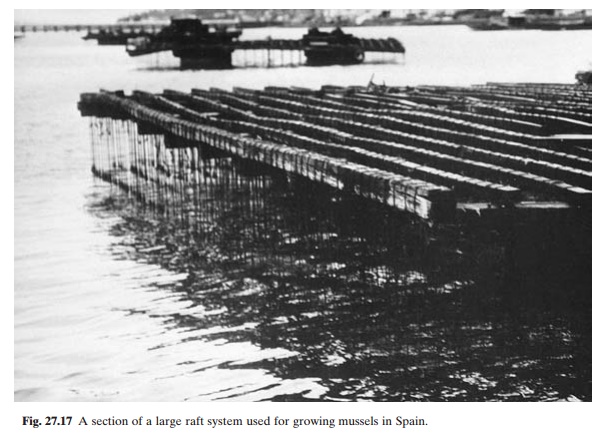Chapter: Aquaculture Principles and Practices: Oysters and Mussels
Culture systems of Mussels
Culture systems
The
systems adopted for the culture of mussels are very similar to those used in oyster
culture. Bottom culture is widely practised in the Netherlands and Germany;
‘bouchet’ (posts or stockade) or stick culture in France, Italy and other
Mediterranean countries and the Philippines; and raft and longline culture in
Spain, Sweden and New Zealand.
On very
muddy coasts with gentle slopes and large tidal oscillations, bouchet and stick
culture give good results. Bottom culture is suitable for coastal areas with
stable and hard bottoms which are submerged for long periods. In shallow estuaries
and bays with a low tide coefficient, cultivation on hanging ropes is
preferred. The raft method is generally practised in protected areas, with
steep coastal profiles and considerable tidal oscillations, at depths of at
least 3m at the lowest neap tides.
Bottom
culture is entirely based on seed produced in natural beds, and the mussels are
more exposed to predators and pests. The mussel parks are located in shallow,
enclosed or partially diked areas.
The
bouchet system of culture (fig. 27.16) originated in France in the early 13th
century and an Irishman, Patrick Walton, who was shipwrecked in the Bay of
Aiguillon, appears to

have
devised the technique based on his observations of the settling behaviour of
the blue mussel on the poles of the equipment he used to capture fish. Rows of
wooden poles of about 3–6 m length, called bouchets, are driven into the bottom
of intertidal zones, to form the park for growing mussels on ropes. The rows
are normally at right angles to the coastline and spaced about 15–20 m apart,
the distance between poles in each row being about 20cm to 1 m. The lower part
of each pole above the sea bottom is covered with smooth plastic sheets to
prevent predators like crabs from reaching the mussels. In stick culture,
bamboo or wooden sticks replace the bouchets and are used for spat collection
as well as for on-growing.

The raft
system of culture is generally practised in protected areas like the rias of
Spain, in depths of at least 3 m at the lowest low tide (fig. 27.17). Different
types and sizes of rafts are in use, ranging from those constructed with
thehulls of old fishing vessels to concrete and steel platforms or pontoons
with styrofoam and fibreglass floats. There is a wooden lattice framework over the
floats, to which ropes containing young mussels are attached. The outside of
the wooden platform and floats is protected from wood-boring organisms (mainly Teredo and Limnoria) by coating with cement, antifouling paints, strips of
fibreglass or other synthetic material. The size of a raft varies from about
400 m2, which can carry some 500 ropes of mussels, to 700 m2
or more, carrying 1000 or more ropes. They are built in such a way as to create
minimum resistance to surf. The rafts are anchored by long, strong chains (six
or seven times longer than the depth of water at the site), facilitating
adequate movements and providing strength to withstand bad weather conditions.
The long-line system of culture developed in Sweden (Lutz, 1985) consists of a series of horizontal
lines of about 10 m length, buoyed up by a number of suitable floats and
anchored down with concrete blocks or other anchoring systems. On these lines a
number of vertical ‘substrate’ lines are hung. The length of these lines can
vary, but in the shallow fjords (less than 10m depth) where they are operated
in Sweden, it seldom exceeds 0.5 m. The lengths are standardized, in order to
mechanize harvesting. The system is reported to work well under the freezing
conditions and low tidal ranges in Swedish fjords.
The
long-line culture system has been tried on an experimental basis in France to
improve the quality of the mussels grown in lagoons and other similar sites.
One-year-old mussels are raised on long-lines in the sea for about eight
months, where they achieve faster growth and better taste.
Related Topics